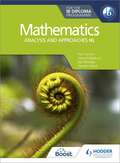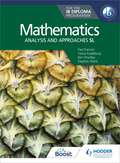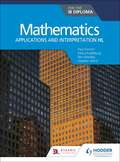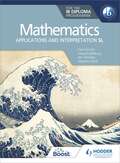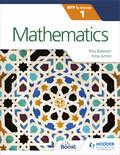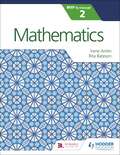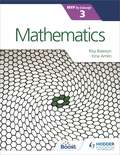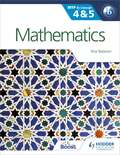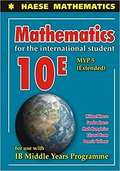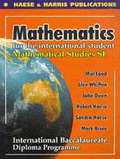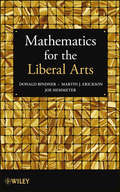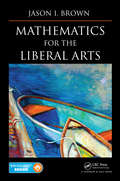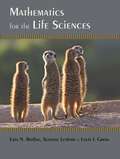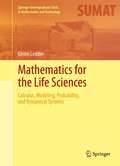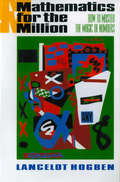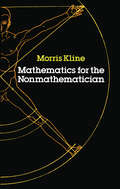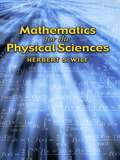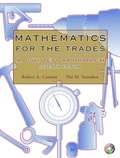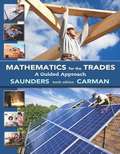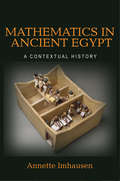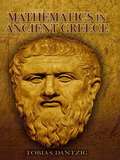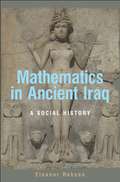- Table View
- List View
Mathematics for the IB Diploma: Analysis and approaches HL
by Stephen Ward Huw Jones Paul Fannon Vesna Kadelburg Ben WoolleyEnable students to construct, communicate and justify correct mathematical arguments with a range of activities and examples of maths in the real world.- Engage and excite students with examples and photos of maths in the real world, plus inquisitive starter activities to encourage their problem-solving skills- Build mathematical thinking with our 'Toolkit' and mathematical exploration chapter, along with our new toolkit feature of questions, investigations and activities- Develop understanding with key concepts and applications integrated throughout, along with TOK links for every topic- Prepare your students for assessment with worked examples, and extended essay support- Check understanding with review exercise midway and at the end of the coursebookFollows the new 2019 IB Guide for Mathematics: analysis and approaches Higher Level
Mathematics for the IB Diploma: Analysis and approaches SL
by Stephen Ward Huw Jones Paul Fannon Vesna Kadelburg Ben WoolleyDeveloped in cooperation with the International Baccalaureate®Enable students to construct, communicate and justify correct mathematical arguments, with a range of activities and examples of maths in the real world.- Engage and excite students with examples and photos of maths in the real world, plus inquisitive starter activities to encourage their problem-solving skills- Build mathematical thinking with our 'Toolkit' and mathematical exploration chapter, along with our new toolkit feature of questions, investigations and activities- Develop understanding with key concepts and applications integrated throughout, along with TOK links for every topic- Prepare your students for assessment with worked examples, and extended essay support- Check understanding with review exercise midway and at the end of the coursebookFollows the new 2019 IB Guide for Mathematics: analysis and approaches Standard LevelAvailable in the seriesMathematics for the IB Diploma: Analysis and approaches SLStudent Book ISBN: 9781510462359Student Book Boost eBook ISBN: 9781398334304Exam Practice Workbook Mathematics for the IB Diploma: Analysis and approaches SL 9781398321182Exam Practice Workbook Mathematics for the IB Diploma: Analysis and approaches SL Boost eBook 9781398342316Mathematics for the IB Diploma: Analysis and approaches HLStudent Book ISBN: 9781510462366Student Book Boost eBook ISBN: 9781398334311Exam Practice Workbook Mathematics for the IB Diploma: Analysis and approaches HL 9781398321878Exam Practice Workbook Mathematics for the IB Diploma: Analysis and approaches HL Boost eBook 9781398342361SL & HL Boost Subscription: 9781398341265
Mathematics for the IB Diploma: Applications and interpretation HL
by Stephen Ward Huw Jones Paul Fannon Vesna Kadelburg Ben WoolleyEnable students to construct mathematical models by exploring challenging problems and the use of technology. - Engage and excite students with examples and photos of maths in the real world, plus inquisitive starter activities to encourage their problem-solving skills. - Build mathematical thinking with our 'Toolkit' and mathematical exploration chapter, along with our new toolkit feature of questions, investigations and activities. - Develop understanding with key concepts and applications integrated throughout, along with TOK links for every topic. - Prepare your students for assessment with worked examples, extended essay support and colour-coded questions to highlight the level of difficulty and the different types of questions. - Check understanding with review exercise at the end of the textbook. Follows the new 2019 IB Guide for Mathematics: applications and interpretation Higher LevelAvailable in the seriesMathematics for the IB Diploma: Analysis and approaches SLStudent Book ISBN: 9781510462359 Student eTextbook ISBN: 9781510461895 Whiteboard eTextbook ISBN: 9781510461901 Mathematics for the IB Diploma: Analysis and approaches HLStudent Book ISBN: 9781510462366 Student eTextbook ISBN: 9781510461857 Whiteboard eTextbook ISBN: 9781510461864 SL & HL Teaching & Learning Resources ISBN: 9781510461918 Mathematics for the IB Diploma: Applications and interpretation SLStudent Book ISBN: 9781510462380 Student eTextbook ISBN: 9781510461994 Whiteboard eTextbook ISBN: 9781510462007 Mathematics for the IB Diploma: Applications and interpretation HLStudent Book ISBN: 9781510462373 Student eTextbook ISBN: 9781510461956 Whiteboard eTextbook ISBN: 9781510461963 SL and HL Teaching & Learning Resources ISBN: 9781510462014 Dynamic learning packages (include Teaching & Learning resources and Whiteboard eTextbooks)Analysis & approaches SL & HL ISBN: 9781510461925Applications and interpretation SL and HL ISBN: 9781510462021 Analysis & approaches SL & HL and Applications and interpretation SL and HL ISBN: 9781510468474
Mathematics for the IB Diploma: Applications and interpretation SL
by Stephen Ward Paul Fannon Vesna Kadelburg Ben WoolleyEnable students to construct mathematical models by exploring challenging problems and the use of technology. - Engage and excite students with examples and photos of maths in the real world, plus inquisitive starter activities to encourage their problem-solving skills. - Build mathematical thinking with our 'Toolkit' and mathematical exploration chapter, along with our new toolkit feature of questions, investigations and activities. - Develop understanding with key concepts and applications integrated throughout, along with TOK links for every topic. - Prepare your students for assessment with worked examples, extended essay support and colour-coded questions to highlight the level of difficulty and the different types of questions. - Check understanding with review exercise midway and at the end of the textbook. Follows the new 2019 IB Guide for Mathematics: applications and interpretation Standard Level
Mathematics for the IB MYP 1
by Rita Bateson Irina AmlinA concept-driven and assessment-focused approach to Mathematics teaching and learning.- Approaches each chapter with statements of inquiry framed by key and related concepts, set in a global context- Supports every aspect of assessment using tasks designed by an experienced MYP educator- Differentiates and extends learning with research projects and interdisciplinary opportunities- Applies global contexts in meaningful ways to offer an MYP Mathematics programme with an internationally-minded perspective
Mathematics for the IB MYP 2
by Rita Bateson Irina AmlinA concept-driven and assessment-focused approach to Mathematics teaching and learning.- Approaches each chapter with statements of inquiry framed by key and related concepts, set in a global context- Supports every aspect of assessment using tasks designed by an experienced MYP educator- Differentiates and extends learning with research projects and interdisciplinary opportunities- Applies global contexts in meaningful ways to offer an MYP Mathematics programme with an internationally-minded perspectiv
Mathematics for the IB MYP 3
by Rita Bateson Irina AmlinA concept-driven and assessment-focused approach to Mathematics teaching and learning.- Approaches each chapter with statements of inquiry framed by key and related concepts, set in a global context- Supports every aspect of assessment using tasks designed by an experienced MYP educator- Differentiates and extends learning with research projects and interdisciplinary opportunities- Applies global contexts in meaningful ways to offer an MYP Mathematics programme with an internationally-minded perspective
Mathematics for the IB MYP 3
by Rita Bateson Irina AmlinA concept-driven and assessment-focused approach to Mathematics teaching and learning.- Approaches each chapter with statements of inquiry framed by key and related concepts, set in a global context- Supports every aspect of assessment using tasks designed by an experienced MYP educator- Differentiates and extends learning with research projects and interdisciplinary opportunities- Applies global contexts in meaningful ways to offer an MYP Mathematics programme with an internationally-minded perspective
Mathematics for the IB MYP 4 & 5: By Concept
by Rita BatesonThe only series for MYP 4 and 5 developed exclusively with the IBDrive meaningful inquiry through a unique concept-driven narrative.- Supports every aspect of assessment with opportunities that use the criteria- Gives you easy ways to differentiate and extend learning- Provides a meaningful approach by integrating the inquiry statement in a global context- Develops critical-thinking skills with activities and summative sections rooted in the ATL frameworkFeel confident that you cover the whole framework with standard and extended mathematics included - and Extended clearly signposted.This title is also available in two digital formats via Dynamic Learning. Find out more by clicking on the links at the top of the page.A proof of the first 6 Chapters of the book is now available as an eInspection copy, by clicking the eInspection copy button to the left. Rita Bateson was, until very recently, the Curriculum Manager for MYP Mathematics and Sciences at the International Baccalaureate® (IB) and continues to be involved in curriculum review. She is an experienced teacher of MYP and DP Mathematics and Sciences, and is Head of Mathematics in her current school. She has taught in many international schools in Europe as well as North America. Her interest include overcoming mathematics anxiety in pupils and STEM education. She is also the co-author of MYP by Concept 1-3 Mathematics, with Irina Amlin.
Mathematics for the IB MYP 4 & 5: By Concept (MYP By Concept)
by Rita BatesonExam Board: IBLevel: MYPSubject: MathematicsFirst Teaching: September 2016First Exam: June 2017The only series for MYP 4 and 5 developed in cooperation with the International Baccalaureate (IB)Develop your skills to become an inquiring learner; ensure you navigate the MYP framework with confidence using a concept-driven and assessment-focused approach to Mathematics presented in global contexts.- Develop conceptual understanding with key MYP concepts and related concepts at the heart of each chapter.- Learn by asking questions with a statement of inquiry in each chapter. - Prepare for every aspect of assessment using support and tasks designed by experienced educators.- Understand how to extend your learning through research projects and interdisciplinary opportunities.Feel confident that you cover the whole framework with standard and extended mathematics included - and Extended clearly signposted.This title is also available in two digital formats via Dynamic Learning. Find out more by clicking on the links at the top of the page.A proof of the first 6 Chapters of the book is now available as an eInspection copy, by clicking the eInspection copy button to the left. Rita Bateson was, until very recently, the Curriculum Manager for MYP Mathematics and Sciences at the International Baccalaureate® (IB) and continues to be involved in curriculum review. She is an experienced teacher of MYP and DP Mathematics and Sciences, and is Head of Mathematics in her current school. She has taught in many international schools in Europe as well as North America. Her interest include overcoming mathematics anxiety in pupils and STEM education. She is also the co-author of MYP by Concept 1-3 Mathematics, with Irina Amlin.
Mathematics for the International Student 10E (MYP 5 Extended)
by Edward Kemp Sandra Haese Michael Haese Mark Humphries Pamela VollmarThis book may also be used as a general textbook at about 10th Grade level in classes where students complete a rigorous course in preparation for the study of mathematics at a high level in their final two years of high school. We have developed this book independently of the International Baccalaureate Organization (IBO) in consultation with experienced teachers of IB Mathematics
Mathematics for the International Student: Mathematical Studies Standard Level
by John Owen Mal Coad Glen Whifren Robert Haese Sandra Haese Mark BruceMathematics for the International Student: Mathematical Studies SL has been written to embrace the syllabus for the new two-year Mathematical Studies SL Course, which is one of the courses of study in the International Baccalaureate Diploma Programme.
Mathematics for the Liberal Arts
by Martin J. Erickson Donald Bindner Joe HemmeterPresents a clear bridge between mathematics and the liberal arts Mathematics for the Liberal Arts provides a comprehensible and precise introduction to modern mathematics intertwined with the history of mathematical discoveries. The book discusses mathematical ideas in the context of the unfolding story of human thought and highlights the application of mathematics in everyday life. Divided into two parts, Mathematics for the Liberal Arts first traces the history of mathematics from the ancient world to the Middle Ages, then moves on to the Renaissance and finishes with the development of modern mathematics. In the second part, the book explores major topics of calculus and number theory, including problem-solving techniques and real-world applications. This book emphasizes learning through doing, presents a practical approach, and features: A detailed explanation of why mathematical principles are true and how the mathematical processes work Numerous figures and diagrams as well as hundreds of worked examples and exercises, aiding readers to further visualize the presented concepts Various real-world practical applications of mathematics, including error-correcting codes and the space shuttle program Vignette biographies of renowned mathematicians Appendices with solutions to selected exercises and suggestions for further reading Mathematics for the Liberal Arts is an excellent introduction to the history and concepts of mathematics for undergraduate liberal arts students and readers in non-scientific fields wishing to gain a better understanding of mathematics and mathematical problem-solving skills.
Mathematics for the Liberal Arts
by Jason I. BrownThis textbook teaches everyday mathematics topics to non-math majors at the undergraduate level. Through numerous examples and more than 600 exercises, students learn how to use math seamlessly in a variety of practical areas, from conversion factors, statistics, visualization, money, and risk to games, art, music, and humor. The text develops a logical, real-world approach to data and reasoning. Real-life stories in each chapter capture students' interest and motivate them to work through the math. Ancillaries are available on the author's website.
Mathematics for the Liberal Arts
by Jason I. BrownThis textbook teaches everyday mathematics topics to non-math majors at the undergraduate level. Through numerous examples and more than 600 exercises, students learn how to use math seamlessly in a variety of practical areas, from conversion factors, statistics, visualization, money, and risk to games, art, music, and humor. The text develops a logical, real-world approach to data and reasoning. Real-life stories in each chapter capture students' interest and motivate them to work through the math. Ancillaries are available on the author's website.
Mathematics for the Life Sciences
by Louis J. Gross Suzanne Lenhart Erin N. BodineAn accessible undergraduate textbook on the essential math concepts used in the life sciencesThe life sciences deal with a vast array of problems at different spatial, temporal, and organizational scales. The mathematics necessary to describe, model, and analyze these problems is similarly diverse, incorporating quantitative techniques that are rarely taught in standard undergraduate courses. This textbook provides an accessible introduction to these critical mathematical concepts, linking them to biological observation and theory while also presenting the computational tools needed to address problems not readily investigated using mathematics alone.Proven in the classroom and requiring only a background in high school math, Mathematics for the Life Sciences doesn't just focus on calculus as do most other textbooks on the subject. It covers deterministic methods and those that incorporate uncertainty, problems in discrete and continuous time, probability, graphing and data analysis, matrix modeling, difference equations, differential equations, and much more. The book uses MATLAB throughout, explaining how to use it, write code, and connect models to data in examples chosen from across the life sciences.Provides undergraduate life science students with a succinct overview of major mathematical concepts that are essential for modern biologyCovers all the major quantitative concepts that national reports have identified as the ideal components of an entry-level course for life science studentsProvides good background for the MCAT, which now includes data-based and statistical reasoningExplicitly links data and math modelingIncludes end-of-chapter homework problems, end-of-unit student projects, and select answers to homework problemsUses MATLAB throughout, and MATLAB m-files with an R supplement are available onlinePrepares students to read with comprehension the growing quantitative literature across the life sciencesA solutions manual for professors and an illustration package is available
Mathematics for the Life Sciences: Calculus, Modeling, Probability, and Dynamical Systems
by Glenn LedderMathematics for the Life Sciences provides present and future biologists with the mathematical concepts and tools needed to understand and use mathematical models and read advanced mathematical biology books. It presents mathematics in biological contexts, focusing on the central mathematical ideas, and providing detailed explanations. The author assumes no mathematics background beyond algebra and precalculus. Calculus is presented as a one-chapter primer that is suitable for readers who have not studied the subject before, as well as readers who have taken a calculus course and need a review. This primer is followed by a novel chapter on mathematical modeling that begins with discussions of biological data and the basic principles of modeling. The remainder of the chapter introduces the reader to topics in mechanistic modeling (deriving models from biological assumptions) and empirical modeling (using data to parameterize and select models). The modeling chapter contains a thorough treatment of key ideas and techniques that are often neglected in mathematics books. It also provides the reader with a sophisticated viewpoint and the essential background needed to make full use of the remainder of the book, which includes two chapters on probability and its applications to inferential statistics and three chapters on discrete and continuous dynamical systems. The biological content of the book is self-contained and includes many basic biology topics such as the genetic code, Mendelian genetics, population dynamics, predator-prey relationships, epidemiology, and immunology. The large number of problem sets include some drill problems along with a large number of case studies. The latter are divided into step-by-step problems and sorted into the appropriate section, allowing readers to gradually develop complete investigations from understanding the biological assumptions to a complete analysis.
Mathematics for the Million: How to Master the Magic of Numbers
by Lancelot Hogben"It makes alive the contents of the elements of mathematics."--Albert Einstein Taking only the most elementary knowledge for granted, Lancelot Hogben leads readers of this famous book through the whole course from simple arithmetic to calculus. His illuminating explanation is addressed to the person who wants to understand the place of mathematics in modern civilization but who has been intimidated by its supposed difficulty. Mathematics is the language of size, shape, and order--a language Hogben shows one can both master and enjoy.
Mathematics for the Nonmathematician
by Morris KlinePractical, scientific, philosophical, and artistic problems have caused men to investigate mathematics. But there is one other motive which is as strong as any of these--the search for beauty. Mathematics is an art, and as such affords the pleasures which all the arts afford." In this erudite, entertaining college-level text, Morris Kline, Professor Emeritus of Mathematics at New York University, provides the liberal arts student with a detailed treatment of mathematics in a cultural and historical context. The book can also act as a self-study vehicle for advanced high school students and laymen. Professor Kline begins with an overview, tracing the development of mathematics to the ancient Greeks, and following its evolution through the Middle Ages and the Renaissance to the present day. Subsequent chapters focus on specific subject areas, such as "Logic and Mathematics," "Number: The Fundamental Concept," "Parametric Equations and Curvilinear Motion," "The Differential Calculus," and "The Theory of Probability." Each of these sections offers a step-by-step explanation of concepts and then tests the student's understanding with exercises and problems. At the same time, these concepts are linked to pure and applied science, engineering, philosophy, the social sciences or even the arts.In one section, Professor Kline discusses non-Euclidean geometry, ranking it with evolution as one of the "two concepts which have most profoundly revolutionized our intellectual development since the nineteenth century." His lucid treatment of this difficult subject starts in the 1800s with the pioneering work of Gauss, Lobachevsky, Bolyai and Riemann, and moves forward to the theory of relativity, explaining the mathematical, scientific and philosophical aspects of this pivotal breakthrough. Mathematics for the Nonmathematician exemplifies Morris Kline's rare ability to simplify complex subjects for the nonspecialist.
Mathematics for the Physical Sciences
by Herbert S WilfThis book offers advanced undergraduates and graduate students in physics, engineering, and other natural sciences a solid foundation in several fields of mathematics. Clear and well-written, it assumes a previous knowledge of the theory of functions of real and complex variables, and is ideal for classroom use, self-study, or as a supplementary text. Starting with vector spaces and matrices, the text proceeds to orthogonal functions; the roots of polynomial equations; asymptotic expansions; ordinary differential equations; conformal mapping; and extremum problems. Each chapter goes straight to the heart of the matter, developing subjects just far enough so that students can easily make the appropriate applications. Exercises at the end of each chapter, along with solutions at the back of the book, afford further opportunities for reinforcement. Discussions of numerical methods are oriented toward computer use, and they bridge the gap between the "there exists" perspective of pure mathematicians and the "find it to three decimal places" mentality of engineers. Each chapter features a separate bibliography.
Mathematics for the Trades: A Guided Approach (7th Edition)
by Robert A. Carman Hal M. SaundersThis book provides the practical mathematics skills needed in a wide variety of trade and technical areas, including electronics, auto mechanics, construction trades and many other occupations.
Mathematics for the Trades: A Guided Approach (Tenth Edition)
by Robert A. Carman Hal M. SaundersMathematics for the Trades: A Guided Approach provides the practical mathematics skills needed in a wide variety of trade, technical, and other occupational areas, including plumbing, automotive, electrical and construction trades, machine technology, landscaping, HVAC, allied health, and many more. <P><P>It is especially intended for students who find math challenging and for adults who have been out of school for a time. This text assists students by providing a direct, practical approach that emphasizes careful, complete explanations and actual on-the-job applications.
Mathematics in Ancient Egypt
by Annette ImhausenMathematics in Ancient Egypt traces the development of Egyptian mathematics, from the end of the fourth millennium BC--and the earliest hints of writing and number notation--to the end of the pharaonic period in Greco-Roman times. Drawing from mathematical texts, architectural drawings, administrative documents, and other sources, Annette Imhausen surveys three thousand years of Egyptian history to present an integrated picture of theoretical mathematics in relation to the daily practices of Egyptian life and social structures.Imhausen shows that from the earliest beginnings, pharaonic civilization used numerical techniques to efficiently control and use their material resources and labor. Even during the Old Kingdom, a variety of metrological systems had already been devised. By the Middle Kingdom, procedures had been established to teach mathematical techniques to scribes in order to make them proficient administrators for their king. Imhausen looks at counterparts to the notation of zero, suggests an explanation for the evolution of unit fractions, and analyzes concepts of arithmetic techniques. She draws connections and comparisons to Mesopotamian mathematics, examines which individuals in Egyptian society held mathematical knowledge, and considers which scribes were trained in mathematical ideas and why. Of interest to historians of mathematics, mathematicians, Egyptologists, and all those curious about Egyptian culture, Mathematics in Ancient Egypt sheds new light on a civilization's unique mathematical evolution.
Mathematics in Ancient Greece (Dover Books on Mathematics)
by Tobias DantzigMore than a history of mathematics, this lively book traces mathematical ideas and processes to their sources, stressing the methods used by the masters of the ancient world. Author Tobias Dantzig portrays the human story behind mathematics, showing how flashes of insight in the minds of certain gifted individuals helped mathematics take enormous forward strides. Dantzig demonstrates how the Greeks organized their precursors' melange of geometric maxims into an elegantly abstract deductive system. He also explains the ways in which some of the famous mathematical brainteasers of antiquity led to the development of whole new branches of mathematics.A book that will both instruct and delight the mathematically minded, this volume is also a treat for readers interested in the history of science. Students and teachers of mathematics will particularly appreciate its unusual combination of human interest and sound scholarship.
Mathematics in Ancient Iraq: A Social History
by Eleanor RobsonThis monumental book traces the origins and development of mathematics in the ancient Middle East, from its earliest beginnings in the fourth millennium BCE to the end of indigenous intellectual culture in the second century BCE when cuneiform writing was gradually abandoned. Eleanor Robson offers a history like no other, examining ancient mathematics within its broader social, political, economic, and religious contexts, and showing that mathematics was not just an abstract discipline for elites but a key component in ordering society and understanding the world. The region of modern-day Iraq is uniquely rich in evidence for ancient mathematics because its prehistoric inhabitants wrote on clay tablets, many hundreds of thousands of which have been archaeologically excavated, deciphered, and translated. Drawing from these and a wealth of other textual and archaeological evidence, Robson gives an extraordinarily detailed picture of how mathematical ideas and practices were conceived, used, and taught during this period. She challenges the prevailing view that they were merely the simplistic precursors of classical Greek mathematics, and explains how the prevailing view came to be. Robson reveals the true sophistication and beauty of ancient Middle Eastern mathematics as it evolved over three thousand years, from the earliest beginnings of recorded accounting to complex mathematical astronomy. Every chapter provides detailed information on sources, and the book includes an appendix on all mathematical cuneiform tablets published before 2007.
